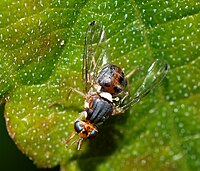
Photo from wikipedia
Females of the olive fruit fly Bactrocera oleae lay their eggs in olives mainly using fruit volatile stimuli. Using GC‐MS analysis, we determined the chemical composition of the volatile blend… Click to show full abstract
Females of the olive fruit fly Bactrocera oleae lay their eggs in olives mainly using fruit volatile stimuli. Using GC‐MS analysis, we determined the chemical composition of the volatile blend emitted from field‐collected olive fruit of cv. Megaritiki, at different stages of maturity. GC‐MS analysis demonstrated qualitative and quantitative differences in the headspace blend emitted by the olive fruit. Certain chemicals such as toluene, n‐octane, α‐pinene, limonene, ethyl hexanol, nonanal n‐dodecane, decanal and n‐tetradecane were detected in greater amounts, irrespective of the growth stage of the fruit. The flies’ exposure to a number of these chemicals, such as n‐octane and α‐pinene, as well as to a mixture consisting of n‐octane, α‐pinene, limonene, ethyl hexanol, nonanal, n‐dodecane, decanal and n–tetradecane favoured successful mating and egg production. The results may contribute to the improvement of the mass rearing of the fly, through these findings, which illustrate the positive effect that certain fruit volatile chemicals have on the fly's reproduction and offer a better understanding of the relation between the fly and the host fruit.
Journal Title: Journal of Applied Entomology
Year Published: 2021
Link to full text (if available)
Share on Social Media: Sign Up to like & get
recommendations!